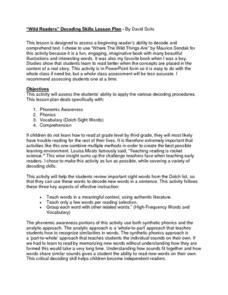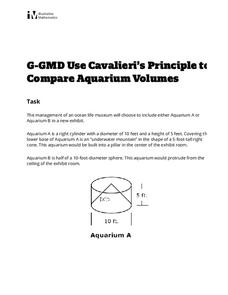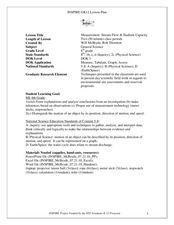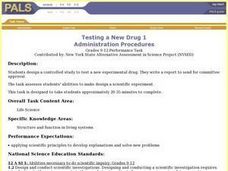Curated OER
The Amazing Starfish
Students study starfish. In this biology lesson plan, students learn the simple but complex characteristics of an echinoderm.
Curated OER
Animal Behavior: "Groggy Goldfish"
Students observe goldfish in different environments. In this biology lesson plan, students watch the behavior of goldfish in water of varying temperatures.
Curated OER
Tree Identification by the Use of Leaves
Students explore trees and their leaves. In this tree identification lesson plan, students observe items and are able to identify them by the five clues they are given. Once the leaves are identified, students in each group sketch the...
Curated OER
Oobleck/Slime War
Students compare slime recipes. In this properties of matter lesson, students make Oobleck and glurch and compare the properties of each and examine the solid and liquid properties of them.
Curated OER
Density: Floating, Sinking, and Suspending
Students observe teacher demonstrations that illustrate density. In this density lesson, the teacher demonstrates how air bubbles in a carbonated drink can cause a raisin to float and how an egg sinks in fresh water, but floats in salt...
Curated OER
Airplanes
Fourth graders experiment with gravity and lift by building paper airplanes. In this physics lesson, 4th graders compare the falling rate of a crumpled vs. flat sheet of paper. Then after class discussion and demonstration of Bernoulli's...
Curated OER
Tempting Temperatures
Students use a thermometer to observe differences in temperature. In this measurement lesson, students use a thermometer to observe the differences in temperature that occur in a refrigerator and a freezer.
Curated OER
The Air Out There
Students build windmills and weather vanes. In this instructional activity on air, students build wind vanes and windmills to demonstrate that air moves. Students determine the direction of air movement and measure the speed at which it...
Curated OER
Mass/Acceleration
Sixth graders examine the relationship between mass and acceleration of an object. In this mass lesson students work in groups and complete a lab.
Curated OER
Imperialism in Africa
Students study imperialism in Africa. In this Imperialism lesson, students consider how democratic revolutions around the world led to imperialism in Africa.
David Suits
“Wild Readers” Decoding Skills Lesson Plan
Set young readers on the path toward fluency with this phonemic awareness resource. Based on the award-winning children's book, Where the Wild Things Are, this lesson allows beginning readers to practice isolating phonemes and...
Teach Engineering
Weather Basics
Weather — there's more to it than meets the eye of the storm. With this resource young meteorologists learn about the basics of weather, including information about the factors that influence the weather, common weather vocabulary, and...
Teach Engineering
Get Me Off This Planet
What do Newton's Laws have to do with getting from Earth to Mars?The activities in this resource show how Newton's Laws work with rockets to get them into space. Background information includes facts about orbits and how orbits are used...
Illustrative Mathematics
Use Cavalieri’s Principle to Compare Aquarium Volumes
Learners are designing a stunning new water feature for an aquarium, but they soon discover that more than just a pretty home for their fishy friends is required. From calculating the volume of a composite shape through the abstract...
Curated OER
Ecosystems
Students role play as members of interest group with a stake in a local land use issue. In preparation for the town hall meeting, students research their issue and gather pertinent information to persuade their audience.
Curated OER
Sopay Water
Tenth graders design and conduct an experiment to explore the use of several substances in removing soap from water. During this activity they work with a lab partner. They keep their own individual lab notes, after they finish, they...
Curated OER
Microscopes: Is what you see, what you got?
Eighth graders identify the parts and functions of the microscope. For this biology lesson, 8th graders observe different samples under different types of microscopes. They compare and contrast the details they see.
Curated OER
Measurement: Stream Flow & Stadium Capacity
Eighth graders study the scientific fields and how information can be monitored and recorded. For this scientific inquiry lesson students view a PowerPoint presentation and complete a hands on activity.
Curated OER
Testing a New Drug 1
Students act as chief research scientists with the responsibility of testing a new drug. Students design a controlled experiment to test a hypothetical experimental drug. Students write a clear, concise, and detailed plan to present to a...
Curated OER
Observing Objects
Students observe the motion of both a pendulum and a spring pendulum . They then explain the differences and the similarities between the two types of motions.
Curated OER
Colored Drops
Students examine the properties of a liquid that contains water and food coloring and a liquid that contains water, food coloring and a liquid detergent. They interpret their data, describe properties, and make reasonable explanations...
Curated OER
Threads
Learners group observed data, filtering from all their observations the similarities between burring threads. In the second part they make a comparison of a chosen attribute between the two threads.
Curated OER
Chemical Changes
Eighth graders observe two types of interactions in a sealed plastic bag. One bag contains baking soda and water, and the other baking soda and vinegar. They determine what evidence indicates that a chemical change is occurring.
Curated OER
Soap, Wood, and Water
Students measure the properties of two different types of soap and wood and calculate their densities. Then they predict whether or not whether or not each object would float or sink in fresh or salt water.

























